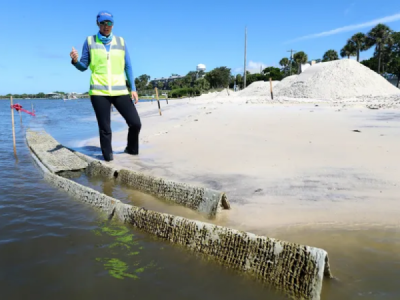
Posted on September 1, 2020
Savanna Berry, a regional specialized extension agent with the University of Florida IFAS Nature Coast Biological Station, talks about the sill, which is a barrier in the water that keeps the sand from eroding and allows sea live to use it as a home, during a shoreline restoration project on G Street in Cedar Key on Wednesday. Brad McClenny
Anytime of the day is a good time on Cedar Key, but dusk is especially good.
Facing west, the horizon of the Gulf of Mexico is the end of the earth for the sun as it’s setting, and G Street is a popular place on the island to watch the day close.
It’s about to get even better. A shoreline restoration project is underway on G Street and on Airport Road that uses a combination of structures and marsh grass to lessen the battering from storms.
“Living shorelines can reduce the energy and erosion and the chronic weakening of the shoreline, but they cannot reduce water levels,” Savanna Barry said. “In a storm surge they can definitely reduce the velocity and power of the water coming in. It won’t prevent flooding, but it may make flooding less damaging.”
Barry is a regional specialized agent with Sea Grant and the University of Florida’s Institute of Food and Agricultural Sciences. She is based at the IFAS Nature Coast Biological Station on Cedar Key.
The station is heading the project with money from the U.S. Environmental Protection Agency and a small grant from the Florida Fish and Wildlife Conservation Commission.

Lots of meetings were held in town to get ideas and thoughts from residents, not all of whom were on board.
Among the biggest supporters is Vice Mayor Sue Colson, whose family has been part of the historic aquaculture industry that is still vital to the island’s economy.
Colson, who served many years ago on the Suwannee River Water Management District Governing Board, said the success of an initial, smaller restoration project at Joe Rains Beach between G Street and Airport Road has sold most residents on the work.
“I’ve only waited 18 years for this,” Colson said. “It’s very satisfying personally. My grandchildren played (at G Street) every single day they were in this town, so that was a big personal victory. For the city, it’s a phenomenal victory.”
At the 300-foot G Street site, several low, jetty-like structures called groins have been created and extend about 65 feet into the gulf from the sidewalk.
Groins act to trap sand to keep it from drifting off with currents and other water movement. About 20 feet will be exposed once the project is complete with the remaining length covered by sand.
A sill made of triangle-shaped structures to slow the rush of water during storms is being installed about 40 feet offshore running parallel with the shore.
The structures, called reef prisms, are several feet long and made of jute fiber and a type of cement that has no plastic and a low carbon footprint.
Reef prisms are experimental — completely developed at UF for the project.
The reef prisms are laid end to end. Oysters have already started growing on them but they will not be harvested. Instead, their mass of shells on the prisms will help stem water flow.
“It’s kind of like a demonstration laboratory to show people what can be done,” Barry said. “A lot of times when you see reef restoration projects there are plastic bags (used in the structures) but we tried to avoid plastic.”
Dump trucks full of sand will be unloaded at the two sites. Then blue cordgrass and saltmeadow cordgrass will be planted. One section at G Street will be left as a beach without marsh grass.
The 1,500-foot project off Airport Road has some different features.
Round, concrete “reef balls” — four feet in diameter, almost 3 feet tall and punched with holes — are the structures instead of prisms.
Barry said 384 balls are arranged into16 reefs of 24 balls each. Unlike the unique prisms, reef balls are commonly used for shoreline restoration.
They have another benefit.
“My boss is a fisheries biologist and the first thing he said when he saw them was, ‘That’s some fish habitat,’” Barry said. “These came into the town on semi trucks and created quite a stir. Fishermen understand what these are and even though they are out of the water at low tide, at high tide there will be red fish and tripletail and other fish coming onto these structures to forage.”
Fishing aside, the main function of the reef at both sites is to help protect the roads, sidewalks and utilities under them from weakening by swift water.
That, Colson said, will help the city enormously.
“We’re very excited about this,” Colson said. “It’s another example of Cedar Key, a historical working waterfront, using ingenuity and modern thinking — and thinking ahead — before other communities anywhere.”

Source: gainesville





